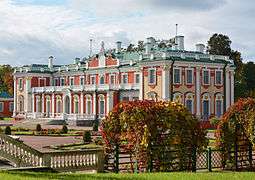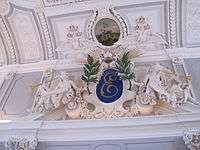Kadriorg Palace
| Kadriorg Palace | |
|---|---|
| Kadrioru loss | |
 Kadriorg Palace in Tallinn | |
| General information | |
| Architectural style | Petrine Baroque |
| Town or city | Tallinn |
| Country | Estonia |
| Construction started | 1718 |
| Completed | 1725 |
| Client | Peter the Great |
| Design and construction | |
| Architect |
Nicola Michetti Gaetano Chiaveri Mikhail Zemtsov |
Kadriorg Palace (Estonian: Kadrioru loss, German: Catherinethal) is a Petrine Baroque palace built for Catherine I of Russia by Peter the Great in Tallinn, Estonia. Both the Estonian and the German name for the palace means "Catherine's valley". It was built after the Great Northern War to Nicola Michetti's designs by Gaetano Chiaveri and Mikhail Zemtsov. The palace currently houses the Kadriorg Art Museum, a branch of the Art Museum of Estonia, displaying foreign art from the 16th to 20th centuries.[1] The KUMU branch of the museum, showing Estonian art from the 18th century onwards is furthermore situated in the park.[2][3]
Construction

After the successful siege of Tallinn during the final phase of the Great Northern War in 1710 czar Peter the Great of Russia bought a small Dutch-style manor house at Lasnamäe for his wife Catherine. The house today is the result of a drastic renovation ordered by Nicholas I of Russia in 1827.[2][3]
However, plans for a larger palace in the area soon developed and construction of a new palace, Kadriorg, was started on 25 July 1718. Peter and Catherine visited the unfinished residence on several occasions, but after the emperor's death in 1725 Catherine showed no interest in the seaside property. The great hall with Catherine's initials and profuse stucco decor (attributed to Heinrich von Bergen) survives, while many other interiors have been altered.
The gardener Ilya Surmin was responsible for the flower garden with two fountains and the so-called mirage garden on several levels. The layout of the park shares similarities with that of Strelna.[4]
Restoration
After the death of Peter the Great, the palace received little attention from the Russian royal family. It was sporadically visited, by the empress Elisabeth and Catherine the Great. In 1828-1830 extensive restoration works of the palace and grounds took place. Between 1741 and 1917, the palace also housed the civilian governor of the Governorate of Estonia.[5]
After the declaration of independence of Estonia in 1919, the palace became state property. For a time, one of the wings housed the studio of sculptor August Weizenberg while the palace was used for art exhibitions. Between 1921 and 1928 the palace housed what would eventually develop into the Art Museum of Estonia (see below), but in connection with a state visit by the Swedish king Gustaf V of Sweden, the palace was turned into a summer residence for the head of state.[5] In 1934 the palace became the official residence of the first President of Estonia, Konstantin Päts who embarked on extensive and controversial restoration works with the aim of transforming the park and the palace into his private domain. From this era, the library in elaborate so-called Danzig baroque style, completed by architect Olev Siinmaa in 1939 is worth mentioning.[6] A purpose-built presidential palace on the grounds (1938) was designed by Alar Kotli.
The palace became the main site for the Art Museum of Estonia in 1921. The museum was re-housed in temporary locations from 1929 while the palace was being converted into the Estonian president's residence. During the German occupation of Estonia during World War II, the palace was the residence of the civilian governor of occupied Estonia, Karl-Siegmund Litzmann. After 1944, during the Soviet occupation of Estonia, the palace once more served as the main venue for the Art Museum of Estonia although the buildings were neglected and by the time of the restoration of Estonia's independence in 1991, completely run down. Restoration works, supported by the government of Sweden, began in 1991 and the palace re-opened in 2000.[5] It was also decided that a new building would be established nearby for the section of the museum devoted to Estonian art. From 1993 until 2005 a part of the collection could be visited at the Estonian Knighthood House in Tallinn’s city centre.
The restored palace was reopened in the summer of 2000, but it no longer serves as the main building of the museum, but as a branch displaying the museum's collection of foreign art.[7] This art museum has paintings by Bartholomeus van der Helst, Gillis van Valckenborch ("Burning of Troy"), Jacob Jordaens ("Holy Family"), Lambert de Hondt the Elder, Adriaen Cornelisz Beeldemaker ("Hunter on Horseback"), Maria Dorothea Wagner, Julie Wilhelmine Hagen-Schwarz, Bernardo Strozzi, Pietro Liberi, Anton Graff, Angelica Kauffman, Francesco Fontebasso, Cornelis Schut, Mikhail Clodt, and Ilya Repin ("Soldier's Tale").
Gallery
- The front façade
- The rear façade
 From the interior
From the interior The palace in winter
The palace in winter.jpg) The palace grounds
The palace grounds
See also
References
- ↑ "Art Museum of Estonia". Retrieved 16 February 2013.
- 1 2 "Kadriorg". Tallinn in your pocket.
- 1 2 "Кадриорг". Estonianet.ru.
- ↑ Peter Hayden. Russian Parks and Gardens. ISBN 978-0-7112-2430-8. Page 74.
- 1 2 3 "Palace and Its Story". Retrieved 16 February 2013.
- ↑ Taylor, Neil (2010). Estonia. Bradt Travel Guides. p. 116. ISBN 9781841623207.
- ↑ "About the museum". Art Museum of Estonia.
External links
-
 Media related to Kadriorg palace at Wikimedia Commons
Media related to Kadriorg palace at Wikimedia Commons - Kadriorg virtual tour
Coordinates: 59°26′18.91″N 24°47′27.86″E / 59.4385861°N 24.7910722°E